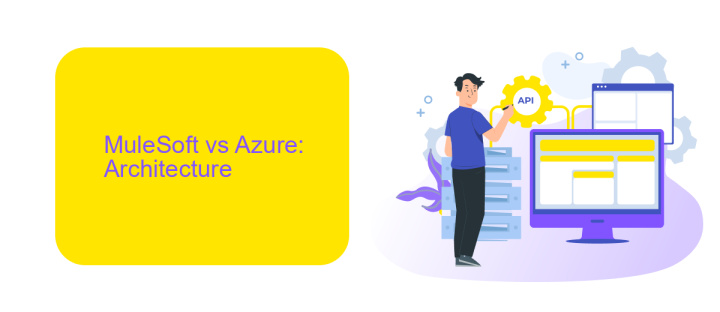MuleSoft Vs Azure
In today's rapidly evolving digital landscape, businesses are increasingly turning to integration platforms to streamline their operations and enhance connectivity. MuleSoft and Azure Integration Services are two leading contenders in this space. This article aims to compare these powerful tools, evaluating their features, capabilities, and suitability for various business needs to help you make an informed decision.
Introduction
In today's fast-paced digital landscape, businesses are increasingly relying on integration platforms to streamline their operations and enhance connectivity. Two of the most prominent players in this realm are MuleSoft and Azure. Both platforms offer robust solutions for integrating disparate systems, automating workflows, and enhancing data accessibility. However, understanding their unique features and capabilities is crucial for making an informed decision.
- MuleSoft: Known for its comprehensive API management and integration capabilities.
- Azure: Offers a wide range of cloud services, including powerful integration tools within its ecosystem.
- ApiX-Drive: A versatile service that simplifies the setup of integrations, making it easier to connect various applications and automate processes.
This article aims to provide a detailed comparison between MuleSoft and Azure, highlighting their strengths and weaknesses. By examining their features, pricing, and use cases, we hope to guide businesses in selecting the platform that best aligns with their integration needs and strategic goals.
MuleSoft vs Azure: Architecture

MuleSoft and Azure offer distinct architectural approaches to integration. MuleSoft's architecture is centered around its Anypoint Platform, which provides a unified solution for API management, design, and integration. It employs a microservices architecture, enabling users to build and deploy reusable APIs and integrations. MuleSoft’s robust connectors facilitate seamless communication between various systems and applications, ensuring efficient data flow and process automation. The platform's API-led connectivity approach allows for modular and scalable integration solutions, making it easier to manage and maintain over time.
Azure, on the other hand, leverages its vast cloud ecosystem to provide integration services through Azure Logic Apps, API Management, and Service Bus. Azure’s architecture is deeply integrated with other Azure services, offering a comprehensive suite for building, deploying, and managing integrations in the cloud. The platform supports a wide range of connectors and pre-built templates, simplifying the integration process. Additionally, services like ApiX-Drive can be utilized to enhance integration capabilities, providing an easy-to-use interface for connecting various applications and automating workflows without extensive coding. This makes Azure a versatile choice for enterprises aiming for cloud-centric integration solutions.
MuleSoft vs Azure: Connectivity

When comparing MuleSoft and Azure in terms of connectivity, both platforms offer robust solutions for integrating various applications and services. MuleSoft provides a comprehensive Anypoint Platform that allows businesses to connect applications, data, and devices with APIs. Azure, on the other hand, offers Azure Logic Apps and Azure API Management to facilitate seamless integrations within the Microsoft ecosystem and beyond.
- MuleSoft Anypoint Platform: Offers connectors for a wide range of applications and services, supporting both on-premise and cloud-based integrations.
- Azure Logic Apps: Provides a visual designer to create workflows that integrate with various Azure services and third-party applications.
- Azure API Management: Allows for the creation, management, and monitoring of APIs, ensuring secure and scalable integrations.
Additionally, services like ApiX-Drive can be leveraged to further enhance connectivity by automating data transfers between different systems without requiring extensive coding. This makes it easier for businesses to streamline their operations and improve efficiency. Ultimately, the choice between MuleSoft and Azure will depend on specific business needs, existing infrastructure, and the desired level of integration complexity.
MuleSoft vs Azure: Features

When comparing MuleSoft and Azure, it's essential to understand the unique features each platform offers. MuleSoft is renowned for its robust API management and integration capabilities, making it a preferred choice for enterprises looking to streamline their data flow across various systems.
Azure, on the other hand, is a comprehensive cloud platform that provides a wide array of services, including computing, analytics, storage, and networking. Its integration services, such as Azure Logic Apps and Azure API Management, enable seamless connectivity between different applications and services.
- MuleSoft: Advanced API management, Anypoint Platform, robust data integration, pre-built connectors.
- Azure: Cloud services, Azure Logic Apps, Azure API Management, extensive scalability, and global reach.
Both platforms have their strengths, but the choice depends on your specific needs. For businesses seeking a dedicated integration solution, MuleSoft offers comprehensive tools. In contrast, Azure provides a broader range of cloud services, making it ideal for organizations looking to leverage a full suite of cloud capabilities. Additionally, services like ApiX-Drive can further enhance integration processes by automating data transfers between different platforms.
Conclusion
In conclusion, both MuleSoft and Azure offer robust solutions for integration and API management, each with its unique strengths. MuleSoft excels in providing a comprehensive API-led connectivity approach, making it an excellent choice for organizations looking to streamline their integration processes across various systems. Its extensive library of connectors and pre-built templates can significantly reduce development time and costs.
On the other hand, Azure Integration Services stand out with their seamless integration within the Microsoft ecosystem, making them ideal for businesses already leveraging Azure's cloud platform. The flexibility and scalability offered by Azure can cater to diverse enterprise needs. For those looking to simplify the integration process further, services like ApiX-Drive can be considered. ApiX-Drive offers an intuitive interface and ready-to-use connectors, enabling quick and efficient integrations without extensive coding. Ultimately, the choice between MuleSoft and Azure should align with your organization's specific integration requirements and technological landscape.
FAQ
What are the primary differences between MuleSoft and Azure Integration Services?
Which platform is better for API management?
How do MuleSoft and Azure handle data integration?
Which platform offers better support for hybrid cloud environments?
What are the options for automating integration tasks on these platforms?
Apix-Drive is a universal tool that will quickly streamline any workflow, freeing you from routine and possible financial losses. Try ApiX-Drive in action and see how useful it is for you personally. In the meantime, when you are setting up connections between systems, think about where you are investing your free time, because now you will have much more of it.

